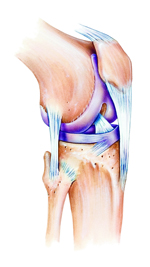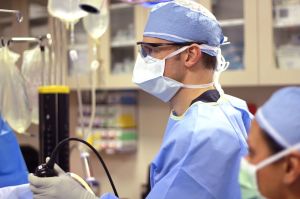Knee Ligament Injury Treatment in Los Angeles
By Steven Meier
 The knee is a complex joint, and must bear almost all the weight of the human body, allowing for the balanced execution of many movements such as walking over rough terrain. As such, the knee joint possesses many structures which act as stabilizers against abnormal movements that could damage it. That job primarily falls upon the leg hinge ligaments in the joint. Any injury to any of these ligaments and the knee joint could be compromised.
The knee is a complex joint, and must bear almost all the weight of the human body, allowing for the balanced execution of many movements such as walking over rough terrain. As such, the knee joint possesses many structures which act as stabilizers against abnormal movements that could damage it. That job primarily falls upon the leg hinge ligaments in the joint. Any injury to any of these ligaments and the knee joint could be compromised.
Steven Meier, MD is the Director of the Center for Progressive Sports Medicine & Orthopedic Surgery. His team of orthopedic surgeons and support staff of nurses are well versed in the ligaments of the leg hinge joint and have performed numerous corrective Arthroscopic knee surgeries on them.
If you believe you may have suffered a knee ligament injury and wish to seek treatment, contact us at (310) 777-7845 to schedule a consultation.
Anatomy of Knee Ligament Injuries
The knee is one of the most commonly injured joints in the body. As the largest joint in the body, the knee marks the junction of the lower thigh bone (femur), the upper shinbone (tibia), and the kneecap (patella). The leg hinge joint is kept stable with the help of four large ligaments, which connect the bones and brace the joint against abnormal types of motion. Another important structure of the leg hinge joint is the meniscus. The meniscus is soft cartilage between the femur and tibia, and it cushions the knee acts as a shock absorber during motion.
The following are the four major ligaments that stabilize the knee:
- ACL (anterior cruciate ligament)
- MCL (medial collateral ligament)
- PCL (posterior cruciate ligament)
- LCL (lateral collateral ligament)
Any injury to these four ligaments could destabilize the knee and require surgical intervention, such as ACL reconstruction, to repair the damage. Luckily, some torn ligaments do not require knee surgery in certain circumstances.
ACL Injuries
 Injuries to the anterior cruciate ligament can be very common among professional and recreational athletes. ACL injuries are often caused by:
Injuries to the anterior cruciate ligament can be very common among professional and recreational athletes. ACL injuries are often caused by:
- Sudden increase or decrease in intensity of activity
- Rapid deceleration while in motion
- Twisting the knee
- Impact to the knee
- Landing improperly on the leg
Treatment for an ACL injury depends on the injury’s severity. If the ACL is completely torn, then patients will typically have to undergo an ACL reconstruction procedure. If the ACL is not torn, then rest and ice will be used in conjunction with rehabilitation in order to help restore the leg hinge joint to proper function after an injury to this very important ligament. After the procedure, Dr. Meier will help patients develop a plan for ACL reconstruction rehab. medlineplus.gov has more information on ACL injury treatments.
MCL Injuries
The medial collateral ligament is a ligament that attaches from the inner side of the thighbone to the inner side of the shinbone. The MCL stabilizes the knee against lateral forces traveling from the outer side toward the knee’s inner side.
There are three grades of MCL injury:
- Grade 1: The MCL is partially torn. The injury is not severe and will heal in one to two weeks.
- Grade 2: The MCL is partially torn, but more severe than grade 1. Surgery is not required but will take between three to four weeks to fully heal.
- Grade 3: The MCL is fully torn. A knee brace will be worn to allow the MCL to heal properly. It will take at least six weeks for the ligament to fully heal.
The MCL may be affected or damaged alone, or in conjunction with an ACL or meniscus injury.
PCL Injuries
The posterior cruciate ligament is one of the two cruciate ligaments (the other being the ACL) that maintain stability of the leg hinge joint and correct femur and tibia bone alignment.
Treatment for a PCL injury is determined on an individual basis. Some patients do not require surgery and can benefit from physical therapy rehabilitation and strength training alone. Dr. Meier will perform an examination to determine the best therapy for any patient who has an injury of the PCL.
Here are some quick PCL facts:
- The PCL is the strongest ligament in the leg hinge joint.
- An injury to the PCL often occurs along with other ligament injuries.
- PCL injuries are commonly found after major traumas to the knee, such as from a car accident.
Dr. Meier uses the latest advances in arthroscopic orthopedic surgery to perform ligament reconstruction surgery in Los Angeles.
LCL Injuries
A lateral collateral ligament injury is an injury to the ligament on the knee’s outer side. The LCL connects the top part of the fibula (the bone on the outside of the lower leg) to the lower outside part of the femur. LCL injuries can be a stretch, partial tear, or complete tear of the ligament.
Injury to the LCL is usually caused by a force or motion that causes stress toward the knee’s outer side where the LCL resides.
Symptoms of injury to the lateral collateral ligament can be:
- Knee swelling.
- Locking or catching of the knee with movement.
- Pain or tenderness along the outside of the knee.
- The knee gives way, or feels like it’s buckling, when active or stressed.
Initial treatment for an LCL injury can include:
- Ice to the area.
- Nonsteroidal anti-inflammatory medications (NSAIDs).
- Raising/elevating the knee above heart level.
 Physical activity should be limited until pain and swelling subside. Patients may be told specifically not to put any weight on the knee when walking. Your doctor might recommend a knee brace and crutches to protect the ligament. Once pain and swelling go away, exercises to strengthen and stretch the leg hinge joint should be performed, and physical therapy could be prescribed to regain knee and leg strength.
Physical activity should be limited until pain and swelling subside. Patients may be told specifically not to put any weight on the knee when walking. Your doctor might recommend a knee brace and crutches to protect the ligament. Once pain and swelling go away, exercises to strengthen and stretch the leg hinge joint should be performed, and physical therapy could be prescribed to regain knee and leg strength.
Thankfully, surgery may not typically be needed to repair a torn LCL. However, the lateral collateral ligament is usually injured during significant knee trauma, including knee dislocations, and therefore LCL injuries are often accompanied by other knee ligament injuries to the MCL or ACL. When significant injuries to multiple ligaments occur, surgery is needed to repair the damage, restoring stability, and preventing future instability of the knee.
Schedule Knee Ligament Injury Treatment
Knee ligament injuries can cause serious problems in your everyday life, especially when it comes to movement or function. While not all injuries will require surgery, it is still best to have an experienced orthopedic surgeon examine your knee to determine the best course of treatment in order to ensure a healthy knee in the future.
For more information, or to schedule a consultation, contact our Beverly Hills orthopedic surgeons at (310) 777-7845 or fill out the contact form on our website.
Next, find out more about Knee Replacement.
